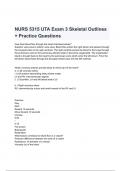NURS 5315 UTA Exam 3 Skeletal Outlines
+ Practice Questions
How does blood flow through the heart chambers/valves?
Superior vena cava to inferior vena cava. Blood then enters the right atrium and passes through
the tricuspid valve to the right ventricle. The right ventricle pumps the blood to the lungs through
the pulmonary valve to the pulmonary arteries where it becomes oxygenated. The oxygenated
blood is brought back to the heart by the pulmonary veins which enter the left atrium. From the
left atrium blood flows through the bicuspid (mitral) valve into the left ventricle.
Which coronary arteries provide blood to which part of the heart?
a. ) Left coronary artery
i.) Left anterior descending artery:widow maker
LV and RV, interventricular septum
ii. ) Circumflex: LA and left lateral wall of LV.
b. ) Right coronary artery
RV, interventricular sulcus and small vessels of the RV and LV
Previous
Play
Next
Rewind 10 seconds
Move forward 10 seconds
Unmute
0:00
/
0:15
Full screen
Brainpower
Read More
What factors contribute to blood flow in a vessel?
Pressure difference between two ends of a vessel
Resistance: r/t diameter of a vessel
Viscosity (n) of the blood
,Length (l) of the vessel
What does QP: QS mean and what factors alter a normal ratio?
Q=blood flow
QP= blood flow to the lungs (pulmonary) : QS= blood flow to the body (systemic)
i ) Vascular resistance =measures in woods units
ii) Pulmonary vascular resistance (PVR)
1. ) <8 weeks of age: 8-10 woods units/m2
2. ) >8 weeks of age: 1-3 woods units/m2
iii) Systemic vascular resistance
1. ) Infant 10-15 woods units/m2
2.) 1-2 years old: 15-20 woods units/m2
3.) Child to adult: 15-30 woods units/m2
a) Factors affecting resistance
i.) Compliance-ease that blood travels through the arteries
1. Constriction and relaxation of smooth muscle of arteries and arterioles
a. ) Sympathetic nervous system
b.) Local tissue metabolism
c.) Hormone responses
d.) Changes in chemical environment
Explain the process of cardiac contraction and relaxation.
What are the roles of actin, myosin, and troponin in this process?
At rest, active sites on actin are blocked by troponin and tropomyosin complexes. During action
potential, troponin C binds with calcium and moves the complexes off the active site. Actin and
myosin interact (contract).
"Walk-along" theory:
Head of myosin cross-bridge attached to the actin filament at the active site.
Intra molecular forces cause the myosin head to tilt forward on a flexible hinge and drag the
actin filament with it (power stroke)
Myosin head breaks away and interacts with the next active site.
Z disc pulls filaments together at the sarcomeres= muscle contraction.
What is the effect of Epinephrine on the cardiovascular system?
Stronger Alpha 1 than Alpha 2. Works on both, equally strong on Beta 1 (renin release), and
Beta 2. Positive inotrope. Increases heart rate, smooth muscle contraction, myocardial
contractility, coronary flow, increased systolic blood pressure, mild increase in diastolic blood
pressure.
,What is the effect of Norepinephrine on the cardiovascular system?
Slightly stronger Alpha 2 than Alpha 1. Some effect on Beta 1, none on Beta 2. Strong
vasoconstriction (smooth muscle contraction). Increase coronary flow, increase systolic and
some diastolic BP.
What is the effect of Dopamine on the cardiovascular system?
Positive inotrope. Increases HR, increases BP (vasoconstriction) Alpha 1, 2, beta 1 and
dopamine receptors)
What is the process of generating a cardiac action potential?
What electrolytes are involved?
0-Depolarization
1-Early repolarization
Rapid sodium entering the cell
2. Plateau (repolarization)
Slow sodium and calcium enters the cell
3. Potassium moves out of the cells
4. Return to resting potential
Sodium, Calcium, Potassium
What is the conduction pathway?
SA Node, AV Node, Bundle of His, Right & Left Bundle Branches, Perkinje Fibers
How does conduction correlate with the EKG and activity in the heart?
P-wave: spread of depolarization through the atria followed by atrial contraction.
P-R interval: pause in conduction at the A-V node
QRS complex: Depolarization of the ventricle, followed by ventricular contraction
T wave: depolarization of the ventricles, happens just before the end of ventricular contraction
Define preload.
Volume of blood returning to the heart from systemic circulations. RA pressure or CVP
Define afterload.
Systemic pressure=the pressure the heart must pump against to circulate blood=MAP
, Define stroke volume.
Amount of blood ejected with each contraction of the heart
Define end-diastolic volume.
Amount of blood in the heart after filling, before systole (end of diastole)
Define end-systolic volume.
Amount of blood that remains in the heart after systole
Define ejection fraction.
Percentage of blood in the chamber that is ejected with each systole
Define cardiac output.
Amount of blood pumped into the aorta each minute
What are the causes, risk factors, pathophysiology and manifestations of atrial fibrillation?
Risk factors/causes: Heart failure, ischemic heart disease, HTN, obesity, obstructive sleep
apnea, rheumatic heart disease, thyroid disease
Patho: Remodeling of the myocytes of the myocardium-atria does not fully contract to empty
contents. Estimated 25% loss of blood from the artia to ventricle.
Manifestations: Fatigue, dizziness, dyspnea, irregular pulse, palpitations.
Untreated: at risk for thrombus formation and stroke
What are the causes, risk factors, pathophysiology and manifestations of premature ventricular
contractions (PVCs)?
Risk factors/causes: Abnormal electrolytes (hypokalemia, hypercalcemia), hypoxia, aging,
induction of anesthesia, central line placement, cardiac cath, caffeine intake, drug use, exercise.
Patho: Decreased cardiac output from lack of atrial contribution to ventricular preload
Manifestations: fluttering, pound, palpitations
What is the role of lipoproteins?




